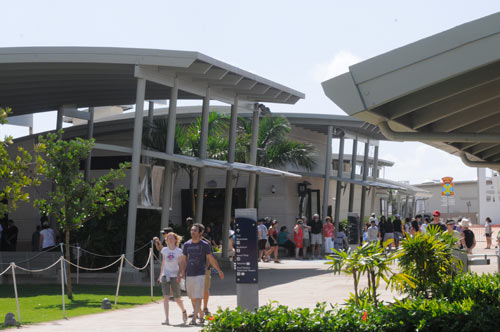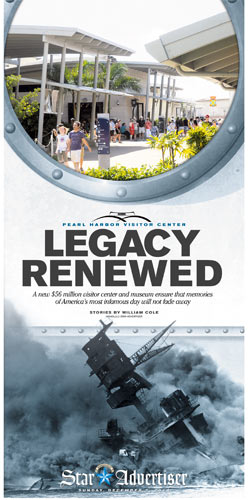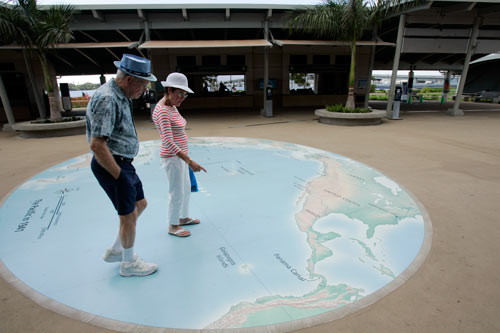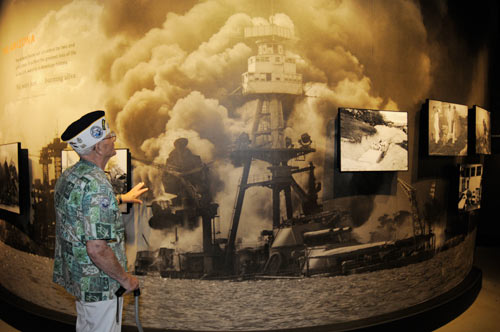Legacy renewed

Visitors walk by the anchor of the USS Arizona on the grounds of the USS Arizona Memorial visitors center.

The commemorative cover featuring the new Pearl Harbor Visitors Center in remembrance of the 1941 Pearl Harbor attack, published in the Honolulu Star-Advertiser, December 5, 2010.

Sheldon and Evie Joyce stood at the Map of the Pacific 1941, which is located near the entrance to the center. They are residents of Honolulu and Illinois. Behind them is the ticketing counter. More than 1.5 million people visit the memorial annually.

Pearl Harbor survivor Sterling Cale looks at the large photo of the USS Arizona burning as he toured the Pearl Harbor Visitor Center museum for the first time. "We'll tell (people) the story, but here you see the story," said Cale, who was a Navy pharmacist mate 2nd class at the time of the attack.



With every passing year, there are fewer who were there on Dec. 7, 1941, who witnessed the shock, bombs and bloodshed and who actually do "Remember Pearl Harbor" — which became a rallying cry that cut to the bone for America after the surprise Japanese attack.
John Finn, who shot back at enemy planes at Kaneohe Bay with a heavy machine gun, was wounded more than 20 times and received the Medal of Honor, died at the age of 100 on May 27.
Jim Bounds remembered getting hit by multiple torpedoes on the battleship Oklahoma, the big ship rolling over, and being pulled out a day and a half after the attack. Bounds died Sept. 3 at the age of 88.
Out of a crew of 1,511 on the USS Arizona, only 334 survived, according to the National Park Service. Just 20 are still living, Don Stratton, one of those crew members, said recently.
Their history and that of Pearl Harbor still resonate; more than 1.5 million people visit the USS Arizona Memorial annually — double the number that the previous visitor center, built in 1980, was designed to accommodate.
The park service is about to finalize a $63.2 million plan to relate the history of the "Day of Infamy" in greater detail and complexity — and with greater convenience for visitors — as the number of aged survivors who can tell it themselves dwindles.
Don't miss out on what's happening!
Stay in touch with breaking news, as it happens, conveniently in your email inbox. It's FREE!
69TH ANNIVERSARY PEARL HARBOR DAY COMMEMORATION AND DEDICATION OF THE PEARL HARBOR VISITOR CENTER Sunday Monday Tuesday
|
On Tuesday, the 69th anniversary of the attack, the second half of a new campuslike visitor center and a new museum dedicated to that mission will be opened.
"I think the importance of the museum is the legacy that it leaves us after the survivors and civilian eyewitnesses, these participants, are no longer with us," said Daniel Martinez, chief historian for the World War II Valor in the Pacific National Monument, which includes the Arizona Memorial.
On the morning of Dec. 7, a first wave of 183 Japanese planes launched from carrier decks was followed by 167 in a second wave in attacks on Kaneohe Naval Air Station, Hickam, Wheeler, Ewa and Bellows fields and Pearl Harbor.
In the new museum, exhibit space has doubled from about 3,500 square feet to 7,000 square feet to tell that story, officials said. Video kiosks tell the stories of 45 American and Japanese service members and civilians.
For the first time, there is a 9-foot section of the sunken Arizona’s riveted superstructure blackened by thick oil at what was the waterline, and revealing heat tempering from fire and years of rust.
There is a one-third scale model Japanese Nakajima Type 97 B5N2 "Kate" torpedo bomber — 18 feet from wingtip to wingtip — hanging from the ceiling with a torpedo fixed to its undercarriage.
There is a white uniform worn by Pharmacist Mate 1st Class Robert J. Peth bloodied on Dec. 7 as he worked in the Navy dispensary on Ford Island.
The new museum is divided into indoor "Road to War" and "Attack and Aftermath" galleries and an outdoor "Oahu 1941" exhibit.
For the first time, the Japanese mindset and way of life are shown in period film, photos and diorama cutouts as the flip side — literally — to the American perspective.
A 12-foot-tall, semitransparent photo of President Franklin D. Roosevelt is backed by an equally large photo of Emperor Hirohito astride a white horse. From some angles the image of one bleeds through to the other.
Along with the Japanese experience, the museum incorporates a new candor about the attack’s toll: 2,390 men, women and children killed; 21 ships of the Pacific Fleet sunk or damaged; and 75 percent of the planes on Oahu airfields damaged or destroyed.
Displayed 16-by-20-inch photos reveal the burned body of a dead Army Air Corps service member next to a destroyed car at Hickam Field, civilian casualties at the Honolulu morgue and the body of a Japanese airman washed up on Ford Island.
The casualty photos make up a relatively small part of the museum, but they are there on display, along with some of the racial prejudices from the time.
Many Americans viewed Japan and its people as inferior, and not a serious threat to the United States.
"The Japanese are not going to risk a fight with a first-class nation," U.S. Rep. Charles I. Faddis is noted in one of the exhibits as saying in 1941.
Japan came to embrace a vision of expelling Western imperial powers from East Asia so it could take control of the region itself.
The hatred for the Japanese that followed the outbreak of war is demonstrated in a displayed lapel pin: "Jap Hunting License," it reads. "Open season. No limit."
Japan resented Western prejudice but practiced its own against the Chinese and other Asians, museum exhibits note.
Martinez said that five years ago the National Park Service brought together leading historians as plans were being looked at for a new visitor center and museum.
"(We asked), What kind of story do we want to tell?" Martinez said. "And many of the historians said it’s time that we moved to telling the broader story — that we tell and look at the perspective of what the Japanese were thinking during that time, and what leads them down the road to war with the United States."
Sterling Cale, 89, a Navy pharmacist mate second class who retrieved 46 people from the waters of Pearl Harbor on Dec. 7– some of them dead, some badly wounded and burned — said he was impressed with the new museum.
"We’ll tell (people) the story but here you see the story," Cale said.
Not all the story, though.
Cale recently tapped at a glass case enclosure of a model of the USS Arizona before it was bombed, pointing out references he knew from the horrible aftermath of the sinking.
He and 10 other men were detailed to recover the dead on the battleship, and he recalled seeing ashes blowing off the ship that he realized had been men.
"The Arizona burned for 2 1/2 days. A lot of these men burned right down to the deck," he said. "But I didn’t have anything, and I couldn’t stop the ashes (from blowing away). I just sort of sank down, and I shed a few tears."
Not all survivors agree with the decision to offer the Japanese viewpoint. A film crew was sent to Japan, and vintage news footage and interviews from both the United States and Japan are run in the new museum.
"I don’t give a s— about their (the Japanese) viewpoint. It was a sneak attack and I’ll never forget that," Stratton, 88, said.
The USS Arizona survivor, a Colorado Springs resident, received burns over 65 percent of his body when a Japanese aerial bomb blew up his ship, killing 1,177 shipmates.
Arthur Herriford, 88, president of the Pearl Harbor Survivors Association, said he thinks it is a good idea to incorporate the lifestyle and viewpoints from both countries.
"It was a two-sided affair," the Sherman Oaks, Calif., man said. "The Japanese people serving in the Japanese military at that time were just like the rest of us. They were following orders, and it was their government at that time that gave us the problem."
Martinez, the Valor in the Pacific historian, said Americans continue to remember Pearl Harbor, but in a different way from during the war.
"The message of 1941 has now evolved into a slogan of American history. It doesn’t have the intensity that it had to (propel) a nation to move forward in war, but it has a phrase that calls out to us to remember the sacrifices of Pearl Harbor," Martinez said. "You stand here and know that America changed at that moment out in that harbor."

 Kamaaina Day
Kamaaina Day 

